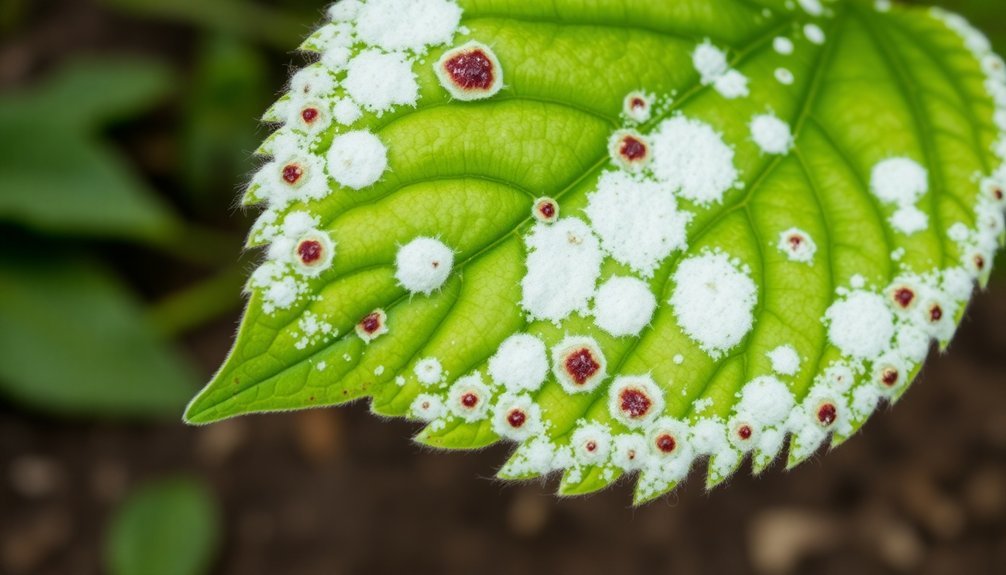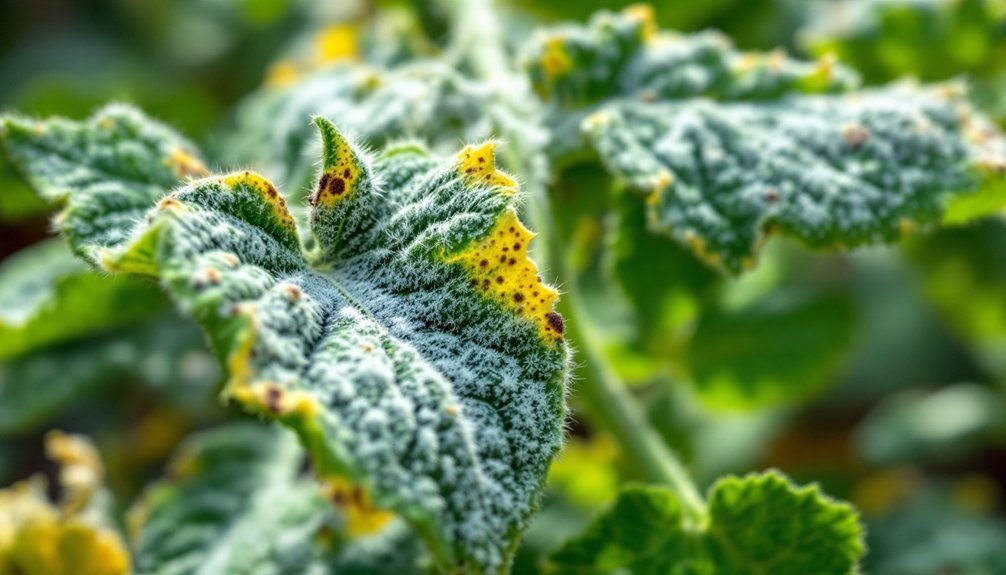Three clear warning signs of fungal infection in your plants include white powdery spots on leaves, abnormal discoloration like yellowing or dark lesions, and brown mushy roots instead of firm white ones. You'll often notice these symptoms alongside wilting or curling leaves, and a foul smell from the soil can indicate fungal presence. Early detection is essential for treating plant fungus, and understanding the complete signs will help you protect your garden's health.
Visual Signs of Fungal Growth on Plant Surfaces

Plant fungus reveals itself through distinct visual markers that can help you identify infections early. Common fungal diseases display specific patterns that you'll notice on infected plant parts.
If you spot white, powdery spots spreading across leaves, you're likely dealing with powdery mildew, especially in warm, dry conditions.
Watch for black spot disease, which creates dark lesions on leaves and is particularly troublesome for roses.
Rust-orange pustules on leaf undersides are a telltale sign of rust fungi, while fuzzy gray patches signal Botrytis blight in damp soil conditions.
Don't overlook downy mildew, which causes yellowing leaves with characteristic fuzzy growth underneath.
These fungal growth patterns often emerge when environmental conditions favor the pathogen, so regular inspection of your plants can help catch problems before they become severe.
Changes in Leaf Color and Texture
When fungal diseases take hold, leaves often display distinctive color changes and textural abnormalities that serve as early warning signs. You'll notice yellowing leaves that might initially resemble nutrient deficiencies but could signal an underlying fungal infection. Watch for these key indicators to identify plant disease early:
| Symptom | What It Means |
|---|---|
| White powdery coating | Powdery mildew thriving in high humidity |
| Rust-orange pustules | Rust fungi, especially in wet conditions |
| Dark spots with rings | Common plant fungal diseases |
| Wilting or curling | Abnormal leaf texture from infection |
According to the University of California, leaf spots with concentric rings typically indicate fungal diseases, while bacterial infections cause wet, angular spots. Early detection of these symptoms allows for prompt treatment before the infection spreads throughout your plant.
Root and Soil Warning Indicators

Although roots remain hidden beneath the soil, they provide essential warning signs of fungal problems in your plants. You'll need to carefully examine your plant's root system and soil conditions to detect early symptoms of fungal infection.
Healthy roots should look white and firm, while brown roots indicate potential root rot.
The telltale sign of root health lies in color – vibrant white signals vitality, while brown warns of decay.
When you're checking the soil, pay attention to warning signs like a foul or sour smell, which suggests anaerobic conditions and active fungal pathogens. If you find the soil is compacted or consistently soggy, you're likely dealing with poor air circulation and overwatering issues.
To prevent these problems, regularly monitor soil moisture by inserting your finger or a probe into the growing medium. This simple practice helps you maintain proper moisture levels and avoid creating an environment where fungal pathogens thrive.
Frequently Asked Questions
How to Tell if Your Plant Has a Fungal Infection?
You'll notice white powder, black spots, or rust-colored patches on leaves. Watch for fuzzy gray mold on flowers and wilting foliage that turns yellow. These symptoms typically worsen in humid conditions.
What Are 4 Signs That a Plant Has a Disease?
You'll notice these 4 key signs of plant disease: yellowing or discolored leaves, spots or patches on foliage, sudden wilting despite proper watering, and unusual growth patterns like stunting or deformities.
What Are the First Signs of Fungi?
You'll first notice white, powdery spots appearing on your plant's leaves. Watch for dark, wet patches, rust-colored pustules underneath leaves, and fuzzy gray mold on flowers. Yellowing leaves often accompany these symptoms.
Can a Plant Recover From Fungal Disease?
Yes, your plant can recover from fungal disease if you catch it early. You'll need to act quickly by removing infected parts, applying appropriate fungicides, and improving growing conditions to boost your plant's recovery chances.
In Summary
Keep a close eye on these three warning signs to catch fungal problems early. If you're seeing fuzzy growth, discolored leaves, or soil issues, don't wait to act. Remove affected areas, improve air circulation, and adjust your watering habits. For severe cases, you'll need to use appropriate fungicides. Regular monitoring and quick response will help keep your plants healthy and fungus-free.





Leave a Reply